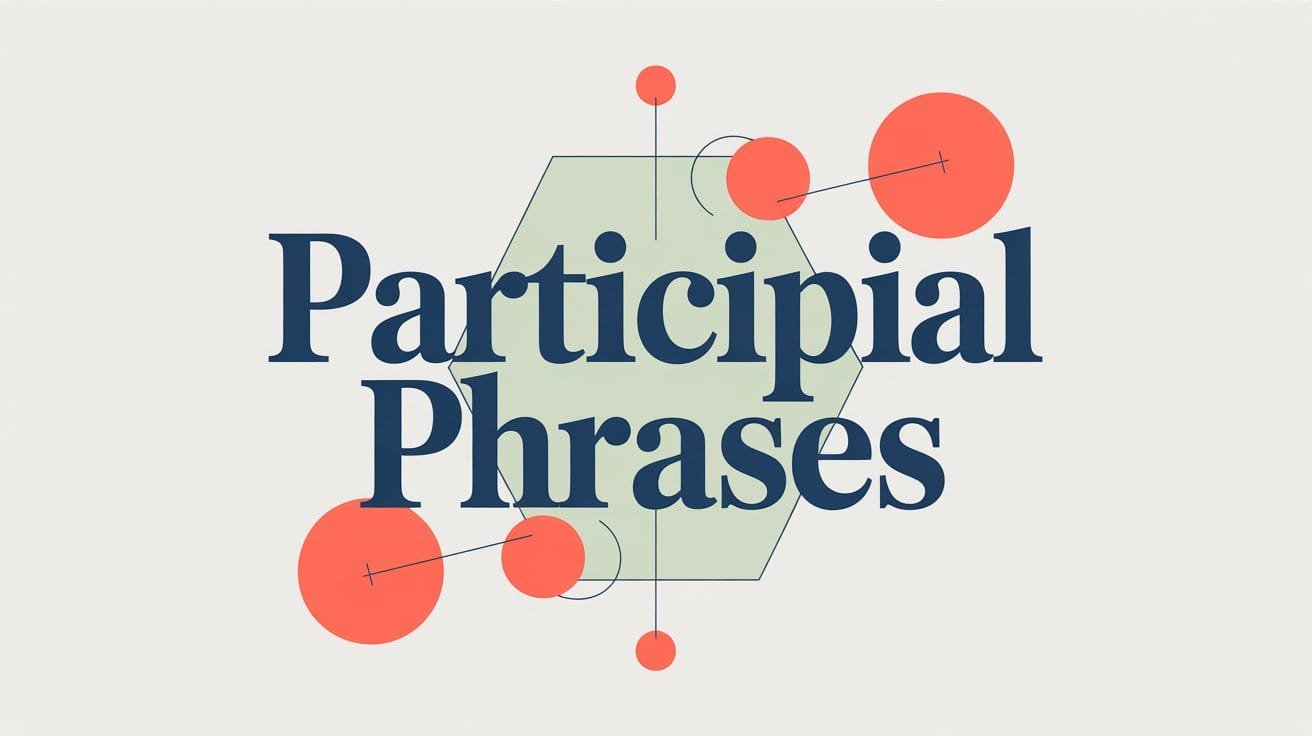Participial phrases help add detail and variety to your writing, allowing you to combine actions and descriptions smoothly. Built around present or past participles, these phrases act like adjectives, modifying a noun or pronoun in the sentence. In this guide, you’ll learn what participial phrases are, how they work, and how to use them with the right structure and punctuation.
What Is a Participial Phrase?
A participial phrase is a group of words that begins with a participle—a verb form used as an adjective, and includes any words that go with it, such as objects or modifiers. Together, the phrase acts as an adjective, giving more information about a noun or pronoun in the sentence.
Structure
Participial phrases are built around two types of participles:
- Present participles end in -ing (e.g., smiling, running, dancing)
- Past participles usually end in -ed, -en, -t, or other irregular forms (e.g., baked, broken, lost)
These phrases do not function as verbs. Instead, they describe a noun, often appearing at the beginning or end of a sentence.
Examples
- Smiling at the camera, Mia snapped a selfie.
(Smiling at the camera modifies Mia) - Exhausted from the long trip, he went straight to bed.
(Exhausted from the long trip describes he) - The car, damaged in the accident, was towed away.
(Damaged in the accident gives more detail about the car)
Used correctly, participial phrases add detail without creating extra sentences. But when used carelessly, they can lead to dangling or misplaced modifiers.
Present Participial Phrases
A present participial phrase begins with a present participle—a verb ending in -ing—and describes a noun or pronoun by showing an action or condition that is happening at the same time as the main verb.
These phrases function as adjectives. They often appear at the beginning of a sentence, but can also follow the noun they describe.
Structure
Present participle (-ing form) + object or modifiers
Examples
- Running down the hill, Marcus waved to his friends.
(Running down the hill describes Marcus) - The dog, barking loudly at the gate, startled the neighbors.
(Barking loudly at the gate modifies the dog) - Singing in the shower, she didn’t hear the doorbell.
(Singing in the shower modifies she)
Key Tip
Make sure the noun immediately following the phrase is the one performing the -ing action. Otherwise, you risk creating a dangling modifier.
Past Participial Phrases
A past participial phrase begins with a past participle—a verb form that typically ends in -ed, but may also take an irregular form like broken, taught, or gone. These phrases describe a noun or pronoun that has already undergone an action or is in a particular state.
Past participial phrases function as adjectives and often express passive or completed actions.
Structure
Past participle (regular or irregular) + object or modifiers
Examples
- Shocked by the news, Liam dropped his phone.
(Shocked by the news modifies Liam) - The window, broken during the storm, was replaced the next day.
(Broken during the storm describes the window; broken is the past participle of the irregular verb break) - Taught by experienced professionals, the course was engaging and practical.
(Taught by experienced professionals modifies the course; taught is the past participle of teach) - Confused by the instructions, the student asked for help.
(Confused by the instructions modifies the student)
Note on Irregular Verbs:
Many commonly used past participles are irregular verbs, meaning they don’t follow the -ed pattern. It’s important to recognize forms like driven, sung, taken, and written as valid participles used in these phrases.
Reminder
Always place the participial phrase directly next to the noun it modifies to avoid unclear or unintended meanings.
Perfect Participial Phrases
A perfect participial phrase begins with the word “having” followed by a past participle (e.g., having finished, having seen, having been chosen). This type of phrase shows that one action was completed before another began.
Like other participial phrases, perfect participial phrases act as adjectives, modifying a noun or pronoun in the sentence. They are especially useful when you want to show that something happened first.
Structure
Having + past participle (+ object or modifiers)
Examples
- Having finished her homework, Maya went outside to play.
(Having finished her homework describes Maya and shows that finishing came before going outside.) - Having been warned about the delay, the travelers arrived early.
(Having been warned modifies the travelers) - Having seen the movie before, I knew what would happen next.
(Having seen the movie before describes I)
When to Use
Use perfect participial phrases when you want to:
- Show a completed action that happened before the main verb
- Add variety and flow to your sentence structure
- Avoid wordy constructions like “After she had finished…”
Why Use Participial Phrases
Participial phrases allow you to add detail to a sentence without creating a full new clause. Instead of writing two separate sentences, you can combine actions or descriptions smoothly using participial phrases. This makes your writing more concise, descriptive, and varied.
Benefits of Using Participial Phrases
- Add description efficiently:
Wearing a bright red coat, Lena stood out in the crowd.
(More engaging than: Lena was wearing a bright red coat. She stood out in the crowd.) - Combine related actions:
Turning off the lights, he left the room quietly.
(Shows two actions clearly and compactly.) - Improve sentence flow:
They reduce repetition and help avoid choppy writing, especially when describing background actions or conditions. - Fit naturally in narrative writing:
Writers often use participial phrases to add movement, emotion, or visual details without slowing down the pace.
Just remember: with these benefits comes the responsibility of correct placement. When participial phrases are misplaced or unclear, they can be confusing.
Placement and Punctuation
Proper placement and punctuation are essential when using participial phrases. Because these phrases act as adjectives, they should always be positioned next to the noun or pronoun they describe. When placed incorrectly, they can lead to confusion or even become dangling modifiers.
Placement Rules
- At the beginning of a sentence: Place a comma after the phrase, and make sure the noun it modifies comes immediately afterward. Example:
Tired from the long journey, Mia went straight to bed.
(Mia is the subject doing the action, placed right after the phrase.) - In the middle of a sentence: Set the phrase off with commas if it adds extra, nonessential information. Example:
The runner, gasping for air, crossed the finish line. - At the end of a sentence: No comma is needed unless the phrase is nonessential. Example:
He stared at the painting hanging above the fireplace.
Punctuation Tips
- Always use a comma after an introductory participial phrase.
- Use commas around nonessential phrases that interrupt a sentence.
- Don’t use commas for short, essential phrases that are closely tied to the noun.
Correct placement and punctuation help participial phrases enhance your writing rather than confuse the reader.
Examples of Participial Phrases
Below are examples of present, past, and perfect participial phrases:
- Clutching her notebook, Ava hurried into the classroom.
- Smiling at the camera, the child posed confidently.
- Running late, Marcus skipped breakfast.
- Exhausted by the workout, Julian collapsed on the mat.
- Chosen for the lead role, Maya began rehearsing the script.
- Damaged in the storm, the roof needed urgent repairs.
- Having completed the design, the team submitted their proposal.
- Having been warned about the noise, the neighbors stayed inside.
- Having lost his phone, Sam retraced his steps through the park.
Participial Phrases vs. Gerund Phrases
Participial phrases and gerund phrases may look similar because both start with a verb ending in -ing, but they serve different grammatical functions.
Participial Phrase
- Acts as an adjective, modifying a noun or pronoun.
- Does not serve as the subject or object of the sentence.
Example:
Running through the field, Daniel felt free.
(Running through the field modifies Daniel; it’s describing what he was doing.)
Gerund Phrase
- Acts as a noun, functioning as a subject, object, or complement.
- Often answers what? in relation to the verb.
Example:
Running through the field cleared Daniel’s mind.
(Running through the field is the subject of the sentence.)
Side-by-Side Comparison
| Function | Example | Phrase Type |
|---|---|---|
| Describes noun | Frightened by the noise, the cat ran away. | Participial Phrase |
| Acts as subject | Frightening the cat was not his intention. | Gerund Phrase |
| Acts as object | He enjoys frightening the cat. | Gerund Phrase |
Tip: If the phrase answers what is happening to/with someone or something, it’s likely a participial phrase. If it acts like a noun, it’s a gerund phrase.
FAQs About Participial Phrases
What is a participial phrase?
A participial phrase is a group of words that begins with a participle and functions as an adjective. It adds detail by modifying a noun or pronoun in the sentence. For example: “Covered in mud, the dog ran inside.”
How do you identify a participial phrase in a sentence?
Look for a phrase that starts with a participle (e.g., running, broken, having eaten) and check whether it’s describing a noun or pronoun. If it’s giving more information about a person, place, or thing, it’s a participial phrase.
What’s the difference between a participial phrase and a gerund phrase?
A participial phrase acts as an adjective. A gerund phrase acts as a noun.
Example:
Participial: “Laughing loudly, she entered the room.” (Describes she)
Gerund: “Laughing loudly can be distracting.” (Subject of the sentence)
Can a participial phrase come at the end of a sentence?
Yes. Participial phrases can appear at the beginning, middle, or end of a sentence, as long as they are placed next to the noun they describe.
Example: “She opened the letter, trembling with excitement.”
What happens if I misplace a participial phrase?
Misplacing a participial phrase can result in a misplaced or dangling modifier, which makes the sentence unclear or grammatically incorrect. Always place the phrase right next to the noun it modifies.



